Double wall carbon steel self bunded fuel cube tank
Structural design
Double-layer structure: It consists of an inner tank and an outer tank. There is usually a certain gap between the two layers, which can provide additional protection and buffering, enhance the safety of the tank and reduce the risk of leakage.
Self-cofferdam design: The tank itself has the function of a cofferdam, and there is no need to set up an independent cofferdam facility. When the inner tank leaks, the self-cofferdam can effectively collect the leaked fuel to prevent it from spreading to the surrounding environment, avoiding pollution and safety hazards.
Square structure: The square design is conducive to saving space, facilitating layout and installation in a limited space, and also facilitating the manufacture and transportation of the tank. Compared with the round tank, the square tank is easier to integrate with other equipment or buildings in some cases.
Material selection
Carbon steel material: Carbon steel is used as the tank material, which has high strength and good wear resistance, and can withstand the pressure and impact during the storage and transportation of fuel. At the same time, the cost of carbon steel materials is relatively low and has good economy. In order to improve the corrosion resistance of carbon steel, the surface of the tank is usually treated with anti-corrosion, such as coating anti-corrosion paint and galvanizing.
Application fields
Industrial field: It can be used in petrochemical, electric power, metallurgy and other industries to store various types of fuels, such as gasoline, diesel, heavy oil, etc., to provide a stable fuel supply for industrial production.
Commercial field: It is used to store and distribute fuel in gas stations, airports, ports and other places to meet the refueling needs of vehicles, airplanes, ships and other means of transportation.
Emergency reserve: It can be used as an emergency fuel reserve facility to provide necessary fuel support to the affected areas in the event of natural disasters, emergencies, etc., to ensure basic production and living needs.
Advantages
High safety: The double-layer structure and self-cofferdam design greatly improve the safety of the tank, and can effectively prevent accidents such as fire, explosion and environmental pollution caused by fuel leakage.
Good environmental protection performance: The self-cofferdam can collect leaked fuel to prevent it from entering the soil and water, reduce pollution to the environment, and meet environmental protection requirements.
High space utilization: The square structure is convenient for compact layout, and more fuel can be stored in a limited space, which improves the utilization rate of land resources.
Low maintenance cost: Compared with some complex storage equipment, the double-layer carbon steel self-cofferdam square fuel tank has a relatively simple structure, which is convenient for maintenance and overhaul, and reduces maintenance costs.
Limitations
Limited corrosion resistance: Although carbon steel has been treated with anti-corrosion, corrosion problems may still occur when storing highly corrosive fuels for a long time or in harsh environmental conditions, affecting the service life and safety of the tank.
General thermal insulation performance: For some temperature-sensitive fuels, the thermal insulation performance of carbon steel tanks may be insufficient, and additional thermal insulation measures are required, which increases costs and complexity.
Limited pressure bearing capacity: Although carbon steel has a certain strength, when storing high-pressure fuels, the tank may need to be specially designed and strengthened to ensure that it can withstand the corresponding pressure.
Precautions
Regular inspection: The tank needs to be inspected regularly, including appearance inspection, leak detection, wall thickness measurement, etc., to promptly discover and deal with potential problems.
Anti-corrosion maintenance: According to the use environment and fuel characteristics of the tank, regular anti-corrosion maintenance is performed, such as re-coating anti-corrosion paint, replacing severely corroded parts, etc.
Safe operation: During the loading, unloading, storage and use of fuel, safety operating procedures must be strictly followed to prevent safety accidents caused by improper operation.
Emergency plan: Develop a complete emergency plan, including the handling of leakage accidents, fire and explosion fighting, etc., to ensure that you can respond quickly and effectively in the event of an emergency.
https://www.sumachine.com/

Recommended Products
Hot News
-
Double wall portable diesel gasoline cube tank with pump sale for Mauritius
2024-11-11
-
Double Walled Portable Fuel TransferCube Tank Ship To Spain
2024-11-07
-
Shipping of portable aviation fuel tank with pump
2024-10-12
-
Carbon steel diesel fuel cube tank ship to USA
2024-11-14
-
Carbon steel cube tank with pump
2024-11-13
-
Fuel Transfer Tank Cube Stationary Double Walled Diesel Storage Tank Sale For Spain
2024-11-06
-
251 US Gallon 552 Gallon Fuel Cube Transfer Tank Sale For USA
2024-11-05
-
251-2000 Gallon Fuel Cube Transfer Tank Sale For Grenada
2024-11-01
-
552 Gallon portable fuel dispenser with tank sale for USA
2024-10-30
-
Mobile fuel tank with pump sale for Spain
2024-10-22
 EN
EN
 AR
AR
 BG
BG
 HR
HR
 CS
CS
 DA
DA
 NL
NL
 FI
FI
 FR
FR
 DE
DE
 EL
EL
 IT
IT
 JA
JA
 KO
KO
 NO
NO
 PL
PL
 PT
PT
 RO
RO
 RU
RU
 ES
ES
 SV
SV
 TL
TL
 ID
ID
 LT
LT
 SR
SR
 SK
SK
 SL
SL
 UK
UK
 VI
VI
 HU
HU
 TH
TH
 TR
TR
 MS
MS
 GA
GA
 IS
IS
 KA
KA
 HT
HT
 KK
KK
 UZ
UZ










